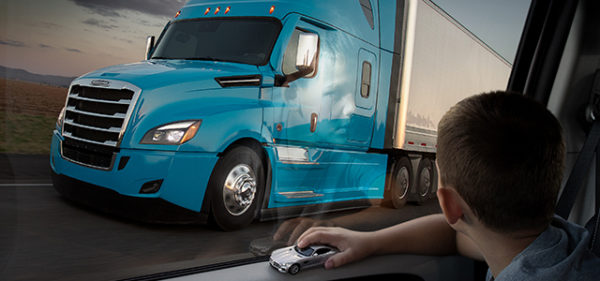A Truckload of Safety Technology
There are approximately 2 million semi-trucks on the road in America, each one capable of hauling 80,000 pounds and logging 2,000-3,000 miles per week. Taken individually, any one of these stats makes it immediately clear why safety is the number one priority at Freightliner. In addition to the safety of the truck drivers and the valuable cargo they carry, they engineered safety features that watch out for other drivers, pedestrians, and even changes in weather.
As you can imagine, it goes way beyond seat belts and air bags. There’s no better example of this advanced safety technology than the Freightliner® Cascadia® heavy-duty truck with Detroit Assurance® 5.0.
A standard feature, Detroit Assurance 5.0 provides optimum on-road safety, integrating seamlessly into any Freightliner Cascadia model equipped with a Detroit® engine and DT12™ or manual transmission built after September 2019. With bumper-mounted radar and windshield-mounted camera, Detroit Assurance 5.0 communicates information to the truck’s brakes, engine and transmission in real time to help mitigate collisions and enhance driver safety.
The level of safety these systems add to even the most experienced driver is truly amazing. Active Brake Assist 5.0 (ABA 5.0), for example, fuses radar and camera technologies for increased confidence in object recognition. ABA 5.0 can alert the driver as well as engage in full or partial braking to mitigate potential collisions.
In addition to detecting vehicles, the new Freightliner Cascadia with ABA 5.0 can also detect pedestrians in motion. When a moving pedestrian enters the truck’s path, Active Brake Assist 5.0 applies input from the radar and camera sensors to warn the driver with visual and audible alerts and applies partial braking. If the driver doesn’t take action, the system is capable of providing full emergency braking to bring the truck to a complete stop.
The Detroit Assurance 5.0 camera system offers an additional layer of assurance and peace of mind. It plays an important role in many features including Adaptive Cruise Control (ACC) to 0 mph, which adds safety as well as convenience. ACC automatically adjusts cruising speed to maintain a safe, continuous following distance ranging from 2.3 to 3.5 seconds from vehicles in its lane ahead. ACC now works in stop-and-go traffic. If the vehicle in front comes to a stop, the new Cascadia will also come to a full stop—0 mph—and hold. If the vehicle in front starts to move within two seconds, then the truck will resume moving at a safe following distance.
Detroit Assurance 5.0 can be upgraded with optional features such as Active Lane Assist (ALA) and Lane Departure Protection (LDP). These features are auto-enabled once speed exceeds 37 mph. The windshield-mounted, forward-facing camera detects the reflective paint and raised reflectors in lane markers. If the truck crosses those markers without the driver using a turn signal, a Lane Departure Warning will be issued first. An audible warning is sent through the corresponding speaker on the side of the truck that crosses the lane marker, along with a visual warning on the instrument panel. If the truck continues to drift out of its lane, it will be actively steered back into its lane.
Additional optional safety features with Detroit Assurance 5.0 include:
- Active Lane Assist** Lane Keep Assist (LKA), which uses micro-steering movements to keep the new Cascadia centered in its detected lane.
- Side Guard Assist** (SGA), which detects objects in the truck’s blind spot and warns the driver not to change into an occupied lane or make a right turn that would cause the truck to make contact with an object or person.
Additional standard safety features with Detroit Assurance 5.0 include:
- Traffic Sign Display which utilizes the windshield-mounted camera to recognize speed limit and other traffic signs and display those signs in the instrument cluster.
- Automatic Wipers/Headlamps. A Rain/Light Sensor detects precipitation on the windshield and low-light situations. When wiper controls are set to the “auto” position, the sensor will automatically turn the wipers on as needed. When the headlight switch is in the “auto” position, the Rain/Light Sensor detects low light and the headlights will automatically turn on. When lighting conditions improve, the headlights will automatically turn off.
- Intelligent High Beam. When the headlight switch is set to auto high beam, the Detroit Assurance camera technology automatically switches to low beams when it detects the headlights or taillights of another vehicle, as well as city lights.
The well-being of everyone on the road is the driving force behind constant safety innovation at Freightliner. Yet there’s also a financial component as well for drivers and truck owners. The Centers for Disease Control and Prevention (CDC) Foundation found motor vehicle crashes cost U.S. employers $25 billion per year*. Even a minor collision can negatively impact your bottom line with unplanned expenses including repairs, lost productivity, missed deliveries, replacement vehicle rental, and towing totaling $10,000 to $20,000 per occurrence. Consider these realities when spec’ing your next truck with a collision mitigation system.
There’s never a substitute for cautious driving, even with all of these many safety features. There is no doubt, however, that they make life a little bit safer and more manageable for everyone on the road. That’s the result of putting as much effort into helping trucks stop, keep their lanes, and mitigate accidents as you do in keeping them moving forward powerfully and efficiently.
Of all the technology in Freightliner trucks, safety is the highest tech priority.
*Source: https://www.cdcfoundation.org/pr/2016/job-vehicle-crashes-cost-us-employers-25-billion-annually

Have your say
This is a moderated forum. Comments will no longer be published unless they are accompanied by a first and last name and a verifiable email address. (Today's Trucking will not publish or share the email address.) Profane language and content deemed to be libelous, racist, or threatening in nature will not be published under any circumstances.